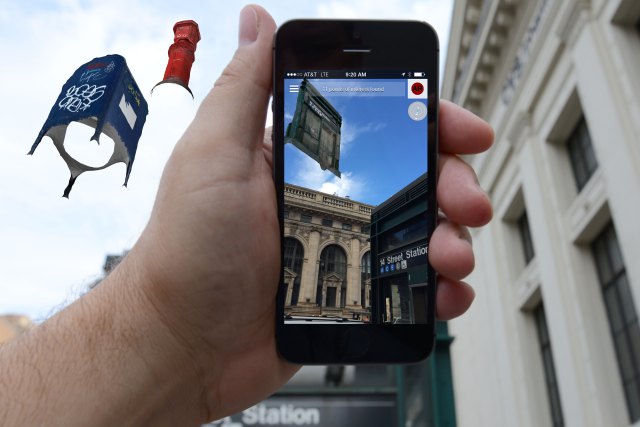Your name/collaborative or group name
John Craig Freeman
The title of your project
14th & AR, New York City
14th & AR, New York City, John Craig Freeman, Art in Odd Places, Free, 2014. Augmented reality public art, New York City, 2014. Image courtesy of the artist.
What does “FREE” mean to you?
Not unlike our political lives, money corrupts art and culture. Ultimately, the art market determines what kind of art gets made and what kind of art get shown. Art that challenges this crass commodification gets marginalized and ignored by institutions and tastemakers. The resulting art of our time is most often reduced to the banal, political vapid and socially irrelevant.
Public art is free to be experience, but not to be made. So even in the public realm, the concept of free has its limits.
Artists and cultural institutions in the twenty-first century can learn from the tithing ethos of open source hacking culture. Utilizing virtual and augmented reality technology as public art is a new proposition that explores all that we know and experience as the mixture the real and the hyper-real. It is now the artist, not the institutions and tastemakers, who decides which artworks can be placed where. Art world power structures, nation states, the nature of art itself, are all called into question. 14th & AR, New York City asks the question, “who will assert dominion over the virtual space that surrounds us?”
Why is 14th Street a compelling site for creative response?
Since 2002, I have worked on the corner of Tremont and Boylston Streets overlooking the historic Boston Common, the first public park in the United States. As I walk across the park every morning, I often contemplate the role that the town square plays in shaping of political discourse and national identity formation. As the location of the public sphere, the town square is traditionally where we make monuments to our heroes and memorials to those we have lost.
Whereas the public square was once the quintessential place to air grievances, display solidarity, express difference, celebrate similarity, remember, mourn, and reinforce shared values of right and wrong, it is no longer the only anchor for interactions in the public realm. That geography has been relocated to a novel terrain, one that encourages exploration of mobile location-based public art. Moreover, public space is now truly open, as artworks can be placed anywhere in the world, without prior permission from curators, governments or private authorities – with profound implications for art in the public sphere and the discourse that surrounds it.
In the early 1990s, we witnessed the migration of the public sphere from the physical realm, the town square and its print augmentation, to the virtual realm, the placelessness, the everywhere-but-nowhere of the Internet. In effect, the global digital network has facilitated the emergence a new virtual space, one which corresponds to the physical geography around us.
The public sphere is now crashing back down to place in the form of place-based virtual and augmented reality, without losing its distributed character or its connections to the vast resources of the world-wide digital network. Imagine now, the entire mobile Internet, and its physical manifestations’ of place, as a world wide public square.
What reactions are you hoping to draw from the public?
A new reality is being built all around us, as our old reality slips away. It occupies the same space as our physical existence and coincided point for point with it. The map of the empire is now the size of the empire. Although we rarely give it a second thought, we encounter and interact with this reality whenever we try to get a mobile signal or wireless network connection. I hope to make visible the virtual reality that now surrounds us, and encourage people to participate in what it is to become.
Union Square is one of New York’s most historically significant town squares. It is an important crossroads, not only for the city, but for the nation. I am interested in the intersection of the virtual and the physical. I hope to make the boundary between the two porous. The goal is to emphasize our need for a new ontology –how we determine what is real, and a new epistemology –how do we know that what we think is real is indeed real.


